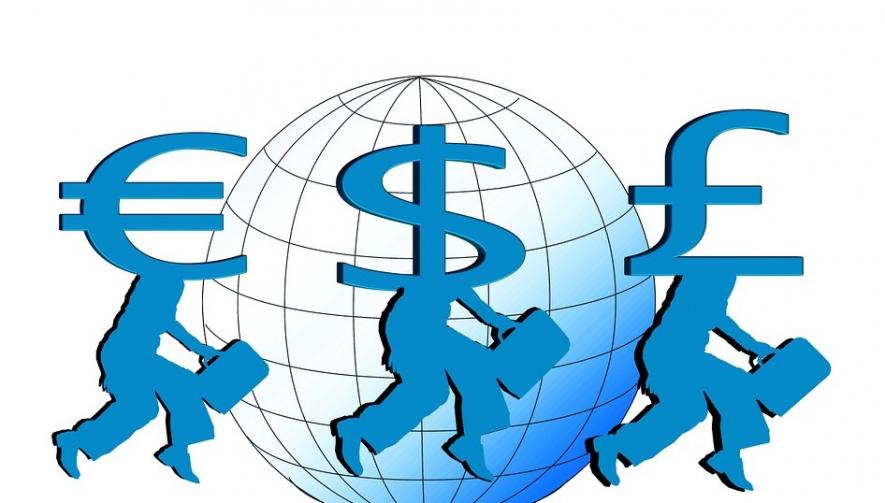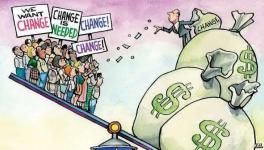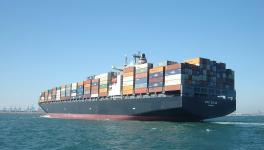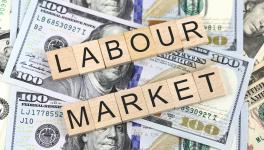World Capitalist Crisis Getting Accentuated

World Capital Crisis
At the last spring meeting of the IMF and the World Bank, Christine Lagarde, the managing director of the IMF, had confidently stated that the world economy was on the path of recovery, a view echoed by most official soothsayers of the system. And yet within days of Lagarde’s remark, fresh data showed that the US economy whose tentative recovery had been the cause of this optimism, was once more slowing down. Since Europe had never really shown much recovery anyway, and since China and India, whose earlier resilience owed much to an unsustainable expansion of credit (CP Chandrasekhar, Frontline, May 26), are also beginning to slow down, the world economic crisis, instead of abating, is getting accentuated.
The recovery in the US, even before the latest setback, had been feeble. Much was made of the fact that the unemployment rate had come down to as low as 4.4 per cent in April 2017. But this decline is less because of a revival of the economy than because of a substantial drop-out from the labour force owing to the difficulty of finding jobs (the “discouraged worker effect”). The labour force participation rate (which measures, as a proportion of the population in the 16+ age-group, all those who are either employed for at least one hour over the previous week, or who are actively seeking work), had come down in the US from 66.1 per cent at the beginning of the crisis in 2008 to 62.9 per cent now. If we calculate the unemployment rate on the assumption of an unchanged labour force participation rate, then it comes to as much as 9 per cent. And this is in addition to the fact that even among those counted as employed, there is substantial under-employment, far greater in extent than before the onset of the crisis. The feebleness of the recovery of the US economy until now can be gleaned from these facts.
But even this feeble recovery, according to the new data, is getting reversed. The “annual” growth rate in the first quarter of 2017 has been only 0.7 per cent compared to 2.1 per cent in the previous quarter, 0.8 per cent in the corresponding quarter of 2016 and 2.0 per cent in the corresponding quarter of 2015. It is the worst quarterly performance of the US economy since the first quarter of 2014. And the significant point is that this recent slowing down has been because of a slowing down of personal consumption expenditure.
Normally in any recovery, consumption expenditure recovers first and then drags investment expenditure upwards. But if consumption itself is slowing down, then the chances of a recovery of the economy as a whole are rather slim, unless of course a stimulus comes either from State expenditure or from net exports; and here Donald Trump’s policy stance becomes important.
Trump has so far taken only a protectionist stance, which means that until now he has thought only in terms of exporting recession and unemployment to other countries. This can of course improve the economy of the US but not of the world as a whole, since it is tantamount to a “beggar-my-neighbour” policy. And even for the US it can succeed in improving the economy only if other countries, to which unemployment is being exported, do not retaliate. When they do, as they inevitably will, not only does this improvement of the US economy vanish, but all countries taken together become collectively worse off than they would have been in the absence of such competitive “beggar-my-neighbour” measures, since these measures undermine capitalists’ “confidence” and hence lower aggregate investment in the world economy.
Trump’s protectionism therefore is no panacea for the crisis in the world economy; it is not even a panacea for the US economy, if it is adopted in isolation, ie, without an increase in the size of the US market (for that would soften the adverse impact on other countries and thereby ward off retaliation on their part). Hence the question arises: what else can he do?
Until now there have been three things that Trump has been reported to be planning to do. One, which is reasonably certain, is a reduction in the corporate tax rate from 35 per cent to 15 per cent. The second is a step-up in spending on infrastructure projects; and the third is an increase in military expenditure, a return to the sort of “military Keynesianism” that the US had resorted to during the fifties and the sixties.
Now all three would entail an increase in the size of the fiscal deficit. While the US does not have any “fiscal responsibility” legislation, and hence nothing prevents it legally from enlarging the fiscal deficit, an increase in this deficit would nonetheless be opposed strongly by finance capital: it would inter alia send signals to other countries too to follow suit and embark on fiscally stimulated expansion strategies which finance capital invariably strongly dislikes.
The arguments usually provided to justify this dislike of finance capital lack any validity. The real reason for its dislike therefore has to do with other considerations, notably the fact that direct State intervention to expand aggregate demand and employment, rather than through providing incentives to the capitalists for this purpose, serves to undermine the very rationale for the existence of capitalists. And finance capital feels particularly vulnerable to any such undermining, since it is managed by what Keynes had called a set of “functionless investors” whose rationale for existence, or social legitimacy, is rather questionable at the best of times.
The Trump administration therefore is unlikely to tread on the toes of finance capital by enlarging deficit-financed State expenditure as a boost to aggregate demand. Not surprisingly it has done nothing much until now by way of actually increasing public infrastructure expenditure, let alone military expenditure. It may of course increase these expenditures in the federal budget, but only by cutting other expenditures, so that the deficit is kept in check; but such reordering of expenditure will not have any expansionary effect on the economy, since the demand generated by larger spending on certain heads will be offset by the contraction of demand owing to reduced spending on others.
The one area where the Trump administration is likely to keep its campaign promise, and even increase the size of the fiscal deficit for doing so, is reducing taxes on the corporate sector. But this is precisely where the expansionary effect on the economy would be minimal. This is because the beneficiaries of such largesse on the part of the State would be capitalists, who would be left with larger post-tax profits; but, since they save much of these profits, little additional aggregate demand will get generated.
Put differently, not all increases in fiscal deficit add to aggregate demand. If an increase in fiscal deficit simply finances transfers that are held as savings, then it has no effect on aggregate demand, which is the case with tax-cuts on the corporate sector. Capitalists’ propensity to consume out of profits within any given time-period is small; so, the tax-cut would not increase consumption expenditure. And since investment occurs only if the level of aggregate demand increases for other independent reasons, the fact that consumption expenditure would not increase as a consequence of the tax-cut would also mean that investment by the capitalists would not increase. The aggregate demand therefore would not increase because of the tax-cut.
And if aggregate demand does not increase within a certain time-period, then the chances of its doing so beyond that time-period are even smaller, as the very persistence of the crisis would make firms more keen on building up their liquid reserves, ie, saving their additional resources, than in making larger dividend payments (and hence making possible larger consumption expenditures) out of these additional resources which have accrued to them through tax-cuts. This point, namely that the proposed Trump tax-cut would not enlarge aggregate demand, is being made by many American economists including Paul Krugman.
It follows therefore that the Trump administration does not have any strategy for expanding demand and employment in the US economy beyond mere protectionism. This is hardly surprising. The current crisis in the world economy arises for two reasons: first, there is a structural crisis because of a tendency towards over-production, whose roots lie in the following. While the vector of real wages across the countries of the world has remained unchanged or even fallen, because of reduced trade union strength in the era of globalisation, which entails greater cross-border capital mobility, the vector of labour productivities has increased significantly. The share of surplus in world output therefore has increased at the expense of the share of wages; and since more is spent on consumption at the margin out of wage incomes than out of surplus incomes, a tendency towards over-production has emerged.
Secondly, this tendency towards over-production which could be kept in check through larger State expenditure financed either by a larger fiscal deficit or by larger taxes on profits (larger taxes on wage incomes do not add much to aggregate demand because wages are substantially spent on consumption anyway). But finance capital opposes both a larger fiscal deficit and larger taxes on profits, which prevents the State, even if it wanted to thwart the tendency towards over-production, to actually do so.
In such a situation there can be some temporary relief at best through the formation of a “bubble”, if it gets formed at all; but its inevitable collapse will bring the world economy once again back to a crisis. We can therefore at best have the world economy behaving like a ball bouncing on the floor, going up briefly to come down again, but not like a projectile that gets propelled upwards. The latest US data only show that the ball that had gone up briefly is coming down to the floor again.
It is not possible to overcome the current crisis of world capitalism without overcoming the hegemony of finance capital which lies at its root. And no bourgeois State is in a position to shake off this hegemony.
Disclaimer: The views expressed here are the author's personal views, and do not necessarily represent the views of Newsclick
Get the latest reports & analysis with people's perspective on Protests, movements & deep analytical videos, discussions of the current affairs in your Telegram app. Subscribe to NewsClick's Telegram channel & get Real-Time updates on stories, as they get published on our website.
























